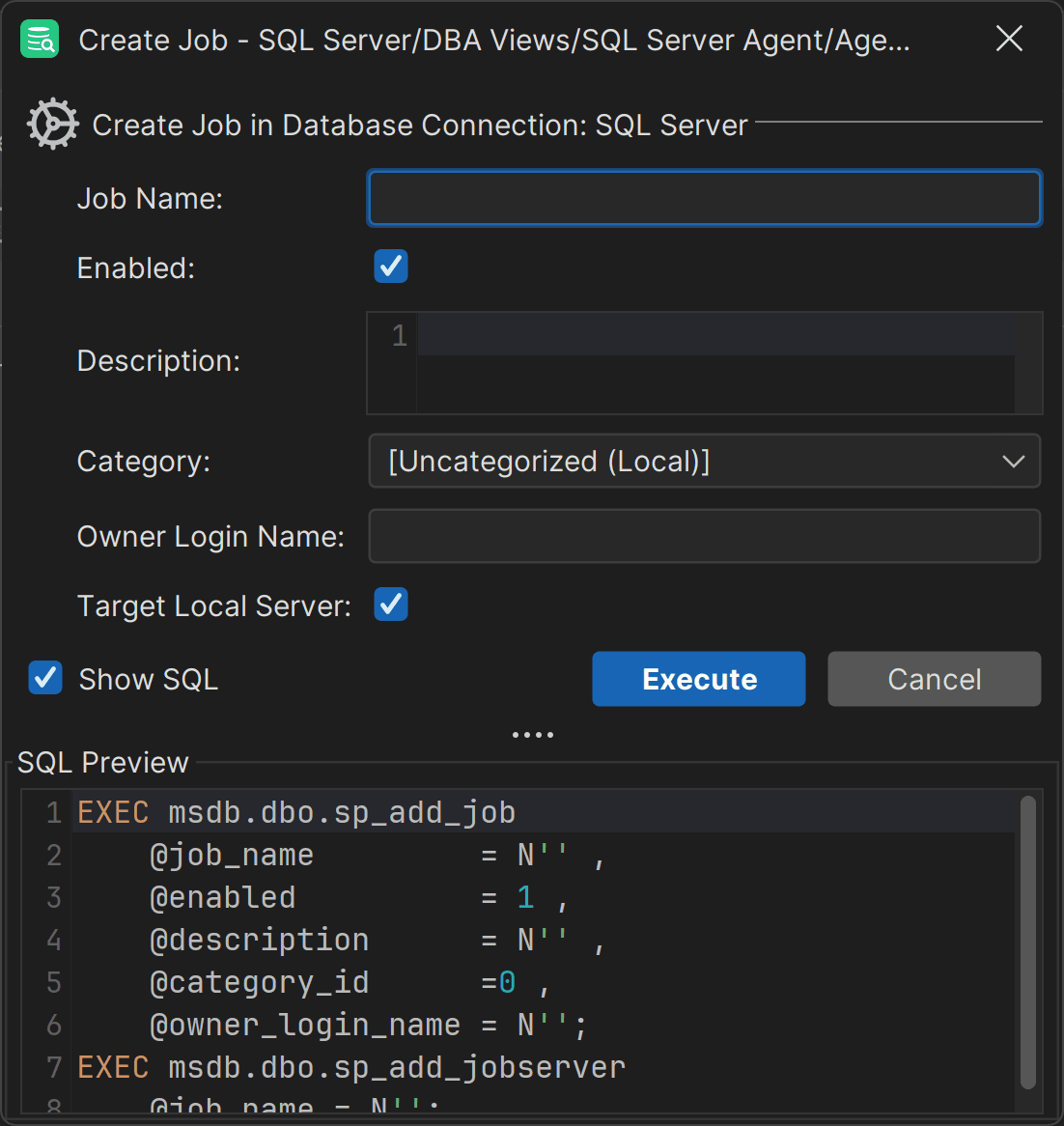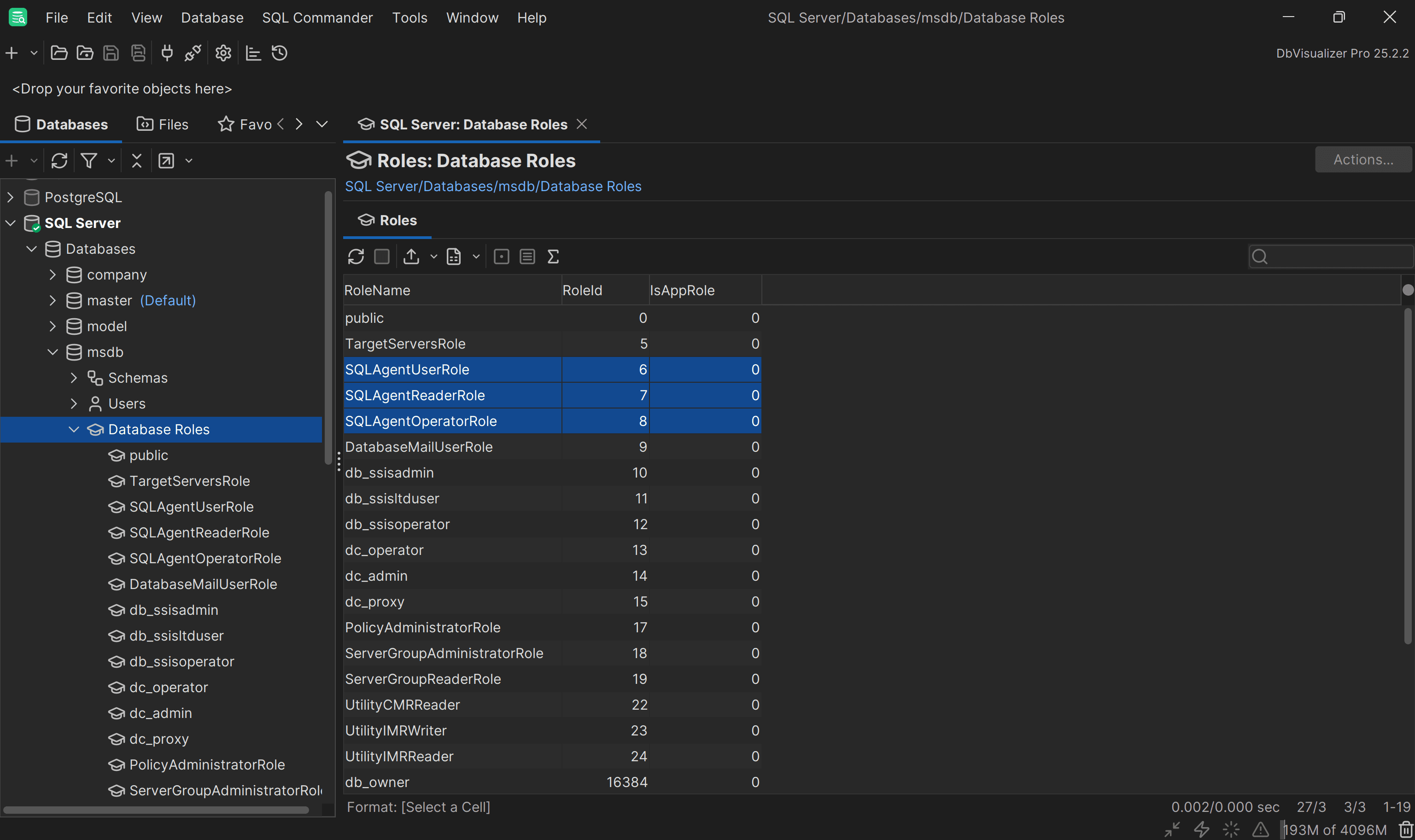intro
Let's understand what SQL Server Agent is and why it is not related to the latest AI agent trends, as you might have thought.
You heard the word “agent,” and your mind probably jumps to the new and exciting AI agents—AI-powered systems capable of autonomously performing tasks on your behalf. SQL Server has an agent too, but it is not related to AI agents at all. In fact, it has existed for years, long before AI became popular. So, let’s explore what SQL Server Agent actually is, where it fits, what it does, and why it is important!
What Is the SQL Server Agent?
The SQL Server Agent is a Microsoft Windows service that executes scheduled administrative tasks (called jobs) in SQL Server (and Azure SQL Managed Instance). After installing SQL Server on a Windows machine, you will find it listed among your system’s Services:

The service is described as:
“Executes jobs, monitors SQL Server, fires alerts, and allows automation of some administrative tasks.”
In other words, SQL Server Agent is a core component of Microsoft SQL Server. It schedules jobs and manages automated tasks such as maintenance plans. It can also send alerts, for example via email, so administrators are promptly notified of important events.
Explaining SQL Server Agent Jobs
In SQL Server Agent, a job is a series of actions that the service performs. Database administrators use jobs to automate administrative tasks that can run once or on a schedule, with built-in monitoring for success or failure.
Each action in a job is called a step. Common examples of SQL Server Agent job steps include:
SQL Server Agent executes a job step by step, moving to the next one depending on whether the previous step succeeds or fails. This process continues until all steps are completed, or the job stops due to a failure. After execution, SQL Server Agent reports the outcome, so you know whether the job ran successfully or encountered errors.
For example, a three-step job could:
You can run jobs in SQL Server Agent in several ways, such as according to one or more schedules, in response to one or more alerts, by executing the sp_start_job stored procedure, and more.
To view information about all existing jobs, query the dbo.sysjobs system table, with
1
USE MSDB
2
GO
3
SELECT job_id, [name] FROM dbo.sysjobs;
Alternatively, you can rely on a visual database client with full support for SQL Server Agent job management, such as DbVisualizer:

In DbVisualizer, you can also create jobs through an intuitive modal:

Why Is the SQL Server Agent Required?
In the Microsoft SQL Server architecture, the SQL Server Agent is fundamental because it automates and manages routine administrative tasks. That reduces manual effort while minimizing human error.
More specifically, it enables database administrators to schedule important jobs such as backups, database maintenance, and log shipping. Beyond routine tasks, it also can handle Reporting Services subscriptions (configurations to deliver reports at a specific time or in response to particular events), execute scripts, and trigger alerts to notify administrators of issues or system events.
In short, by centralizing task scheduling and monitoring, SQL Server Agent helps organizations maintain consistent database performance and uptime.
SQL Server Agent Components
Aside from jobs, the other main components of SQL Server Agent are:

Visually creating a SQL Server Agent job in DbVisualizer
Time to see what these are!
Schedules
A schedule defines when a job should run. Multiple jobs can share the same schedule, and a single job can have multiple schedules.
You can configure schedules to run a job when SQL Server Agent starts, when the CPU is idle, once at a specific time, or on a recurring basis. This flexibility allows DBAs to automate tasks according to system activity and organizational needs.
For more information, see the official guide to creating and attaching schedules to jobs.
Alerts
An alert is an automatic response to a predefined event or condition. Examples include a failed job, a performance threshold being reached, or a specific Windows Management Instrumentation (WMI) event.
Alerts can respond by notifying administrators or triggering a job. This ensures that issues are addressed quickly and consistently, without requiring constant manual monitoring. In simpler words, alerts act as the system’s way of saying, “Hey, something needs your attention.”
Operators
An operator represents the contact information of a person (or team) responsible for managing one or more SQL Server instances. Simply put, operators act as points of contact for alerts.
SQL Server Agent can notify operators through email, pager (via email), or legacy network messages. In small environments, a single operator may handle all alerts, while larger enterprises tend to assign multiple operators to share responsibilities.
Conclusion
In this blog post, you learned more about the SQL Server Agent process. You now understand what it is, how it works, what tasks it handles, and which components it includes. There is no doubt that the service is a key part of any SQL Server instance.
As shown, managing SQL Server Agent jobs, schedules, alerts, and operators becomes much easier with DbVisualizer. This database client fully supports SQL Server and over 50 other databases. Top features include ERD/schema generation and exploration, SQL auto-complete, query formatting, visual query building, and more. Grab a 21-day free trial for DbVisualizer Pro today!
FAQ
How to create a SQL Server Agent job in SQL Server Management Studio?
In SSMS, you can create a SQL Server Agent job by following the official “Create a SQL Server Agent Job in SQL Server Management Studio (SSMS)” guide. This applies to SQL Server Management Objects (SMO).
How to manage the SQL Server Agent components?
Rely on the SQL Server Configuration Manager to manage the SQL Server Agent Windows service. If you instead want to deal with its properties, jobs, alerts, operators, and proxies in a GUI, try SQL Server Management Studio. Otherwise, consider using a SQL Server database client tool like DbVisualizer, which comes with SQL Server Agent integration.
How is security managed for SQL Server Agent?
SQL Server Agent controls authorized access using fixed database roles in the msdb database: SQLAgentUserRole, SQLAgentReaderRole, and SQLAgentOperatorRole for non-sysadmin users.

Additionally, subsystems and proxies guarantee that each job step runs with only the minimum permissions needed, helping administrators enforce the principle of least privilege and keep automated tasks secure.
How to deal with the “SQL Server Agent (Agent XPs disabled)” error?
The message “SQL Server Agent (Agent XPs disabled)" means the Agent XPs option in a SQL Server Agent service is set to 0, preventing it from running jobs in SSMS. To fix this, first enable advanced options:
1
EXEC sp_configure 'show advanced options', 1;
2
GO
3
RECONFIGURE;
4
GO
Then set Agent XPs to 1:
1
EXEC sp_configure 'Agent XPs', 1;
2
GO
3
RECONFIGURE;
4
GO
Finally, restart the SQL Server Agent service via SQL Server Configuration Manager or Windows Services.
SQL Server Agent won't start: What can I do?
If SQL Server Agent fails to start, try the following troubleshooting steps:


